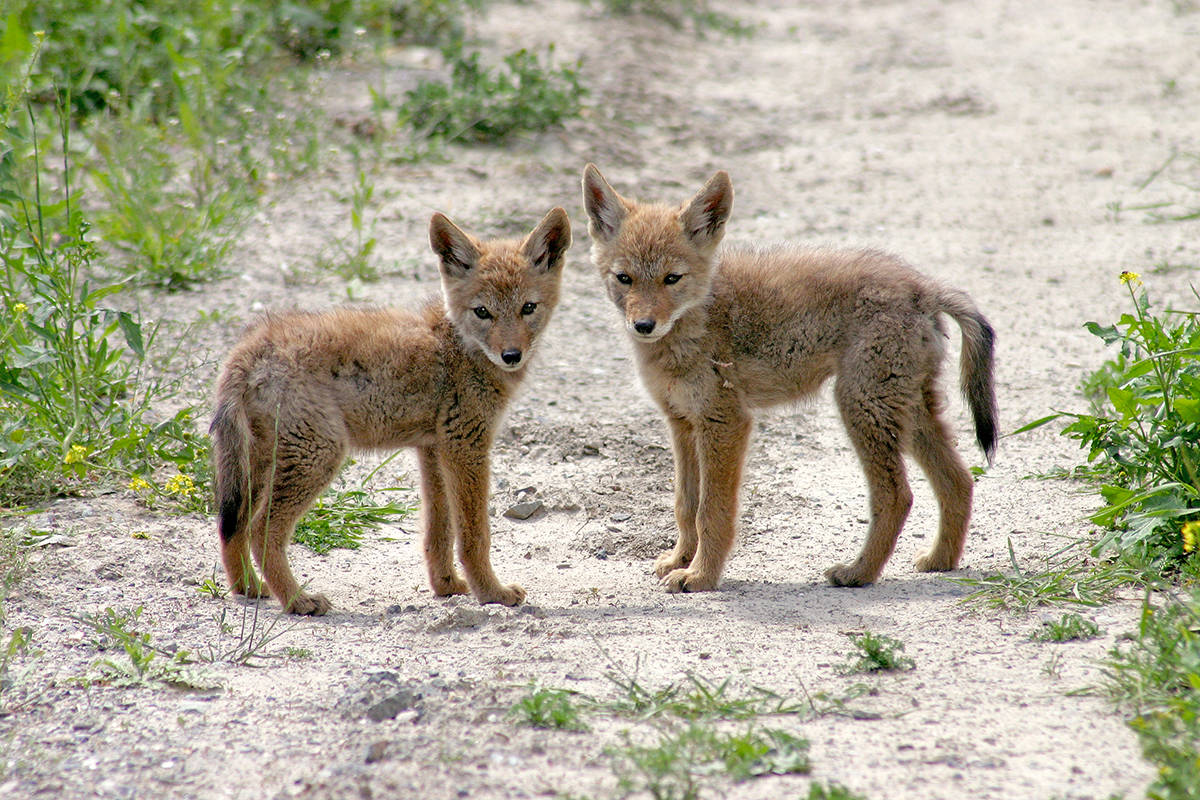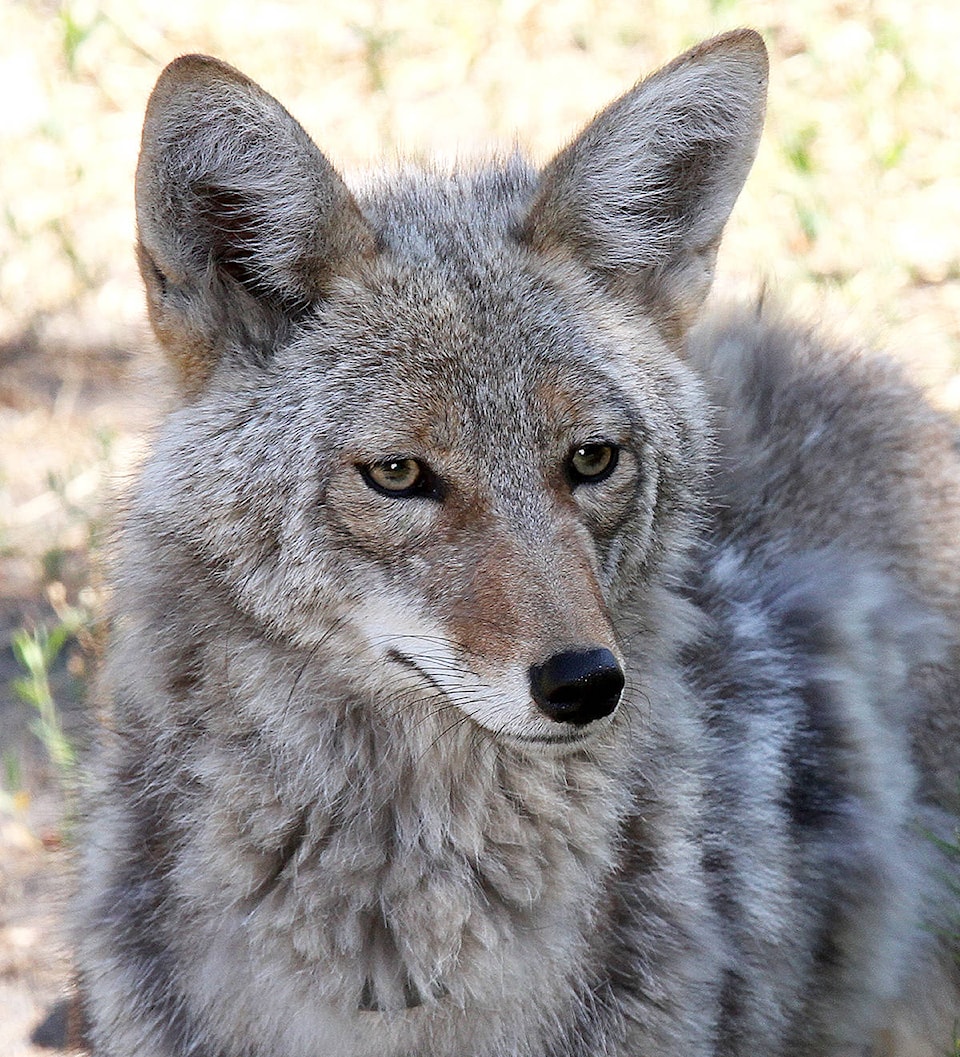It’s been almost three decades since we first made the acquaintance of our neighbours. Their home was just a quarter mile away, and their twice daily travels past our house were as regular as clockwork.
The couple were never apart, were visibly attentive and loving to each other, and we often saw them chasing each other in fun, rolling in the tall grasses of the fields, or sitting in silent comfort beside each other on the ridge overlooking the North Thompson River.
Some days, along with their early morning and evening travels, we would see them jogging side by side along the railway track by the river, hunting in the freshly mowed hay fields, or patiently sitting in cover waiting for a quick lunch.
I am talking about coyotes, in particular a single pair of coyotes who shared our ranch for at least nine years. I say that because they were here before we were. Just like their ancestors were here before man was.
Wild Safe BC says, “Coyote (Canis latrans) is a mid-sized wild dog species. They are the most numerous wild dog species in the province. Smaller than a wolf, yet larger than a red fox. Mature coyotes in B.C. including their tail are 1-1.3m long and weigh approximately 10-20 kg. They have a bushy black-tipped tail which is usually carried down when running unlike wolves that carry their tails out behind them. Coat color varies geographically and can range from grey to reddish with darker areas along the back and lighter areas underneath. They have a slim pointed muzzle, tall prominent ears, long legs and small feet. Where threats are limited coyotes may be observed throughout the day, however more commonly they are active during dusk, dawn and through the night. Average life span of the coyote in the wild is about nine years. Natural predators of coyotes are wolves and cougars. Home range size varies depending on factors such as prey abundance and season. In BC home ranges average between 10-40 square kilometers.”
If you know anything about coyotes you will also know that they all look alike, but if you take the time to really look, you will find many can be distinguished from their brothers and sisters.
The pair who roamed our ranch in Louis Creek were both very distinctive. The male was overly tall for his species with long gangley legs and a small nip from the tip of one ear. The female was small, and had at some time perhaps had almost lost her life had she not been fast enough to get away, because she was missing about three inches from the end of her tail. We often wondered who, or what, had snapped off that tail, was it a wolf, a cougar, or even a trap set to get rid of this so-called “pesky varmint”?
For my family, these “pesky varmints” never caused us any grief. They walked through the cattle herd daily and never touched a calf, they kept their distance from our dogs, and they worked hard at keeping the rodent population down.
They also serenaded us on many a full moon evening, and to add a little spice to their frequent sing-a-longs they would sit just down the hillside from the house, within easy earshot of our dogs, to practice their high notes. Needless to say, this would create much excitement in the house as our dogs ran from window to door in great excitement due to the yodeling going on outside.
If it was early in the year (late January through February) the pair would sit in the driveway right outside our house to sing their song of love, and of course once again waking up the household as the dogs ran pell mell over everything in sight. We were always careful to keep the dogs close during this time of year, much to the disappointment of our canine family.
Regular as clockwork our pair of Nature’s ‘wildies’ produced a litter of pups every year. Sometimes only a couple of pups would finally emerge from the den in May, and other times five, or even seven fuzzy little faces would hesitantly crawl out into the sunshine and a new life. Their parents patiently taught them all the lessons required to survive, hunting, using caution, dangerous places, and of course singing.
By fall all the pups would be gone, although once in a while a few would winter over, but come springtime it would just be Ma and Pa again.
Then one fall, to our shock, the female turned up with no tail at all. It was completely gone. Oh, what a sad thing she looked without her brush of pride carried high behind her. We wondered how she would survive the cold of winter without this furry and warm appendage to help keep her warm?
Perhaps it was just time, and her age was against her; but come spring the male traveled on his own.
And then he was gone as well.
All part of the great wheel that is controlled by Mother Nature, but sad for those who watched, listened and enjoyed our neighbouring coyote pair.
However, as is always the way in Nature, a new family soon moved into the territory and they quickly set up a new den and produced their own families over the years. The pups have grown up, and many were easy to recognize by their spirit of fun, their ability to always act the clown, or their terrible singing voice that could quickly silence any other self-respecting yodeler instantly. We have watched the amazing pigeon hunters who could leap more than 20 feet into the air to grab a pigeon flying from the ground, and shook our heads at the scrounger who returned to the den daily with garbage or dog toys from a neighbouring ranch down the road.
We have also had coyotes who love to run, so much so that they would make a daily stop on the other side of the fence around our large dog run, thus giving them and our dogs an amazing workout as they ran back and forth with tongues hanging out and happy grins, while the dogs did the same amidst much barking. Then all participants in the run would drop to the ground in a shady spot and pant until the coyotes stood up, stretched, and moved on.
We have watched our neighbour the coyote for some 30 years. We know that for many, the coyote is just seen as a pest, but for us they have been good neighbours, and we know that when we are gone they will still be here, singing to the moon, and keeping sentinel on this valley.
Find out more about coyotes and other wildlife from Wild Safe BC at: https://wildsafebc.com/

